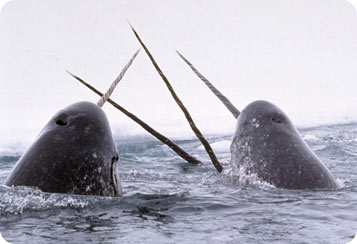 The narwhal's scientific name, Monodon monoceros, means \one tooth
The narwhal's scientific name, Monodon monoceros, means \one toothEach fall, narwhal populations travel north to wintering grounds, where they spend about six months gorging on halibut and other prey. Getting to the bottom-dwelling halibut in these frigid seas brings out the narwhal’s amazing diving ability. In complete darkness under thick pack ice, narwhals dive straight down to depths of at least 2,600 feet — sometimes reaching depths of 4,000 feet or more — making them one of the whale world’s deepest divers!
To cope with the tremendous pressure at these depths, narwhals have flexible rib cages that compress as water pressure increases while they descend. Narwhal muscles, like those of other deep-diving whales and seals, are packed with myoglobin, a protein that boosts their oxygen-carrying capacity so they can dive for 25 minutes or more on a single breath.
These deep dives under the ice can be risky. Narwhals depend on small openings in the ice for access to air, but sudden temperature changes sometimes cause these cracks to freeze over before the whales surface.
But warming Arctic temperatures have scientists concerned about narwhal survival. Loss of sheltering sea ice could leave narwhals more vulnerable to killer whales, and unpredictable temperatures also could disrupt narwhals’ food supply. Researchers are tracking narwhals to learn more about their habits and to gauge their chances of survival in a changing Arctic.


